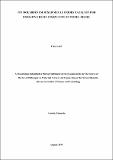| dc.description.abstract | This study reports on synthesis, characterization, and catalytic activity of mesoporous mixed
metal oxides of tin (Sn) and molybdenum (Mo) for sulfur removal from model diesel. Variable
synthesis conditions, namely calcination temperature and Sn/Mo mole ratios, have been on
focus. Several techniques were used to characterize the catalysts, including powder X-ray
diffraction (XRD) for the crystal structure, orientation, and particle size; scanning electron
microscopy (SEM)-EDX for examining the morphological properties of the materials, N2
adsorption-desorption isotherms for textural properties, thermal gravimetric analysis (TGA)
for thermal stability, the Fourier transform infrared spectroscopy (FT-IR) for functionality.
Characterization results show that the adsorption-desorption isotherms are of type IV,
indicative of mesoporous materials. The surface area of the synthesized materials decreased as
calcination temperature increased due to the Ostwald ripening process and increased with the
mole ratio Sn/Mo increase. The X-ray diffraction structural analyses revealed that the
synthesized catalyst had a tetragonal structure. The presence of Mo=O and Sn‒O‒Mo bonds,
which are responsible for the catalytic reaction, is confirmed by FT-IR and Raman analyses.
The activity of the catalysts prepared at various calcination temperatures and mole ratios was
analyzed for oxidative desulfurization of model diesel, dibenzothiophene (DBT). The optimal
synthesis conditions were the calcination temperature of 450 °C and the mole ratio of Sn/Mo
of (2:1). Other multiple parameters affecting the reduction of sulfur compounds were also
investigated, including reaction temperature, catalyst loading, oxidant/sulfur ratio, and reaction
time. The (DBT) removal efficiency was 99.8 % at 60 °C, 100 mg, 5, and 30 min,
correspondingly. This high catalytic activity was due to the surface defects increase,resulting
in a high surface area with high pore distribution around the mesopore region.
Experiments examining the reaction kinetics have indicated that the reaction follows a pseudo first-order behaviour. The activation energy for the reaction has been determined to be 36 ± 4
kJ mol-1
. The rate of the heterogeneous reaction is governed by the Langmuir-Hinshelwood
mechanism. Furthermore, the maximum rate constant value of SnO2-MoO3 catalyst with
Sn/Mo (2:1) molar ratio is 0.057 min−1, which is higher than for pure SnO2 (0.017 min‒1
) and
MoO3 (0.007 min−1
), confirming a synergy between SnO2 and MoO3, promoting oxidative
desulfurization efficiency. The catalyst's high activity and reusability indicate enormous
promise for industrial catalytic desulfurization. | en_US |

